An example of how the EEA Grants have revolutionised the very fabric of a business in Romania
 © Photo: Eva Marie Bulai
© Photo: Eva Marie BulaiThis story begins as Innovation Norway approaches Majutex’s production facilities in a remote village outside of Iasi, in the North Eastern part of Romania. The company, which is family-run and led by Vlad Mancasi, has a rich and long history in the textile industry. Vlad Mancasi proudly showcases a statue of his grandfather in the hall, making reference to the company’s more than 30 years of experience on the Romanian textile market.
Niki Vlad Mancasi (Majutex): “We have more than 30 years of experience in the textile industry. We have the know-how and the potential, but we were very limited before this project. You need the machinery to achieve all your goals. The EEA Grants have been a true helping hand hand”.
A 25-meter “baking oven”
 © Eva Marie Bulai
© Eva Marie BulaiNiki Vlad Mancasi (Majutex): “Our economics rely on this machine. We had a very old stenter frame machine, getting a new one was quintessential for our activity. Things have really changed for the better ever since we received the grants. The work is much easier now: Because of the more advanced software they have in them they eliminate a lot of human errors. They don’t need so much human intervention. They just fix issues on the go".
Most of the investments have been done in the finishing department. They also invested in 3 new weaving looms, and Mancasi says they produce as much as 6 or 7 old looms.
Before vs. Now
Innovation Norway: Can you elaborate on what has specifically changed in your business?
Niki Vlad Mancasi (Majutex): Other than getting greener and more efficient, we have new machinery that makes our lives easier. We´re more confident when it comes to the quality of the products, and we rely more on them than before. Our weaving capacity increased by 30-40%, but the processing capacity increased by 50%, so we are now processing fabrics also for others. For example, clients send over fabrics to have them waterproofed or fire proofed. Our new standards are now so efficient we doubled production on it”.
This automation even allows the company to venture into innovative projects, such as developing a special bed sheet capable of monitoring the efficiency of medication for chronically ill patients.
A bed sheet that measures sleep quality
 © Majutex
© MajutexThe benefits of the EEA Grants do not span just across the production flow, but also have the potential to bring about real innovations in the medical sector and come to the rescue of chronically ill patients. The funding Majutex recieved has also been used to develop two new patents: One of them a very special bed sheet which can track the efficiency of medication on chronically ill patients.
Innovation Norway: How is this possible?
Niki Vlad Mancasi (Majutex): "We have come up with printed circuits made by a special conductive paste, the circuits on the sheet are then connected to a microchip and software which can detect the sleep patterns".
Majutex have worked together with a neurosurgeon on this project. They came up with the idea of detecting the sleep patterns because medication has a huge impact on the patients´ sleep. They are now in the process of patenting the product.
Cooperation with Norway
Majutex has been cooperating with the Norwegian company International Development Norway (IDN) on this project. Textile engineer Silvia Filip Endresen has been their contact.
Silvia (IDN): "In this project they had some impressive results: They increased the turnover and the profit. Only in the last four years I see they doubled the turnover and tripled the profit".
Innovation Norway: What was your role in the cooperation?
- "I took care of the technical organisation. We developed the green line, the green process. We went through each part of the production cycle and came up with suggestions on what should be improved and how. Like minimizing waste, cutting time for the workers to gain more productivity, how to load the workers in a more effective way".
The wide portfolio of Majutex also impresses her.
Silvia (IDN): "As a textile engineer, I am used to see more specialised companies. I worked many years for Italian companies, and they were often specialized in one type of fabric. I also think Majutex is among one of few Romanian companies with their own Research and Development department".
Innovation Norway: What did you gain from this bilateral cooperation?
- "I gained more knowledge of smart textiles. I also extended my professional network. Majutex may become supplier to companies in Norway and I put them in contact with the Norwegian company Fiszk. The communication throughout the project was good, and now that the pandemic is over, the engagement has the potential to increase exponentially".
Overall, it was a win-win for both companies and an outstanding example of a true partnership generating green solutions to real problems.
Join us in celebrating Majutex, the Romanian textile pioneers, whose journey exemplifies the exceptional support and catalytic impact of the EEA Grants. One stich at a time, they transform fabric of their entire business.
Facts
Programme: Business development, Innovation and SMEs
Grant amount: €481.991
Total project cost: €1.008.442
Finalised: July 2021
Results:
- 2 new full-time jobs
- Patent request for 2 new products
- More efficient production processes
- Reduction of 4% (approx. 5000 kg) of yearly material consumption
- Reduction of 10% (approx. 1100 liter) of yearly fuel consumption
- Reduction of 2.5% (approx. 5600 liter) of yearly water consumption
- Increase of raw material re-use/recycling with 30% by 2021
- An increase in the company's profitability
- An increase in the company’s turnover and market competitiveness
This interview has been conducted in collaboration with Eva Marie Bulai
